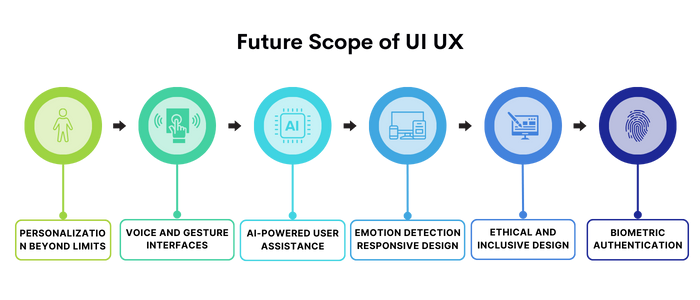Understanding the UI/UX Landscape
Before diving into the specifics, it's essential to grasp the fundamental distinction between UI and UX. UI refers to the visual elements that users interact with, such as buttons, menus, and icons. In simpler terms, it's the look and feel of a product. UX, on the other hand, delves deeper, focusing on the overall experience a user has when interacting with a product. It encompasses usability, information architecture, interaction design, and visual design.
UI UX Design Roadmap for 2024
The UI/UX roadmap outlined in the blog content can be broken down into three main stages:
Stage 1: Building a Strong Foundation
This stage focuses on acquiring the essential knowledge and skills that serve as the building blocks for UI/UX design. Here's what you'll learn:
- Design Fundamentals: Grasp core design principles like hierarchy, balance, contrast, and color theory. These principles are the foundation of crafting visually appealing and functional interfaces.
- Information Architecture (IA): Understand how to organize information logically within an interface. This ensures users can effortlessly find what they're looking for.
- User Interface (UI) Design: Explore UI design tools and become familiar with common UI components. Learn how to design user-friendly interfaces that are easy to navigate and interact with.
Stage 2: Deepening Your Knowledge
Once you have a solid foundation, you can delve deeper into specialized areas of UI/UX design:
- Interaction Design: Learn how to design interactions between users and interfaces. This involves creating fluid, intuitive, and engaging interactions through prototyping and user testing.
- Usability Testing: This is the core of UX design. Here, you'll observe users interacting with your prototypes to identify any usability issues. By incorporating user feedback, you can ensure your designs are truly user-centric.
- Visual Design: Enhance the aesthetic appeal of your UI by honing your skills in typography, color theory, and layout design. This stage focuses on creating visually captivating interfaces.
Stage 3: Refining Your Expertise
This final stage involves solidifying your skills and establishing yourself in the UI/UX design field:
- UI/UX Design Principles: Deepen your understanding of core UI/UX design principles such as user empathy, user-centered design, and iterative design. This empowers you to approach design challenges with a user-focused mindset.
- Portfolio Building: Create a portfolio that showcases your UI/UX design capabilities. This is your calling card when applying for UI/UX design jobs. Include projects that demonstrate your design process and problem-solving skills.
- Staying Updated: The UI/UX design landscape is constantly evolving. Stay informed about the latest trends and design tools by following industry blogs, attending design conferences, and participating in online design communities.
Remember, this roadmap is a flexible guide. Feel free to adjust it to your learning style and interests. The most important aspect is to actively engage in the learning process, experiment with your designs, and have fun along the way!
Future Scope of UI UX

Looking ahead, the future holds exciting possibilities for shaping digital interactions that are more immersive, intuitive, and engaging. Let's peer into the crystal ball and explore the promising avenues that lie in the future scope of UI UX:
1. Personalization Beyond Limits
Personalization is set to reach new heights, leveraging data and AI to create tailor-made experiences. From content recommendations to adaptive interfaces, UI UX design will transform into a virtual concierge, offering unique experiences to each user.
2. Voice and Gesture Interfaces
Voice-activated interfaces, driven by advancements in natural language processing, will become more sophisticated, enabling users to perform tasks, make inquiries, and even navigate interfaces using voice commands. Similarly, gesture interfaces will allow users to manipulate and navigate digital content through intuitive hand movements.
3. AI-Powered User Assistance
AI will play a significant role in UI UX design by providing real-time support, answering queries, and predicting user needs. Chatbots and virtual assistants will become more human-like, offering seamless assistance and enhancing user engagement.
4. Emotion Detection and Responsive Design
AI will evolve to detect user emotions through facial expressions, voice tone, and other cues. Responsive design will go beyond screen size to consider users' emotional states, tailoring the experience to provide comfort, support, and the right content at the right time.
5. Ethical and Inclusive Design
As technology becomes more intertwined with daily life, ethical considerations will gain prominence. UI UX designers will create interfaces prioritizing user privacy, data security, and inclusivity. Designers will play a vital role in shaping products and services that are beneficial and responsible for society.
6. Biometric Authentication
Biometric authentication, like facial recognition and fingerprint scanning, is set to play a fundamental role in the landscape of UI UX design. It will enhance security while providing a frictionless login experience, ensuring users can access their accounts seamlessly.
Final Thoughts
The world of UI/UX design offers a rewarding career path for those passionate about creating user-centered experiences. By following this UI UX roadmap, you'll gain the knowledge and skills necessary to excel in this dynamic field. Remember, the journey is just as important as the destination. Embrace the challenges, continuously learn and iterate, and most importantly, have fun unleashing your creativity to design interfaces that captivate and delight users.
Ready to take the first step? Our beginner-friendly UI UX Designer Course in Chennai will help you unravel the secrets of crafting exceptional digital experiences. Your design adventure starts now!
UI UX Course Schedule
| Name | Batches | Details |
|---|---|---|
| Azure DevOps Training |
Weekend Batch
(Sat-Sun) |
View Details |
| AWS DevOps Training |
Weekday Batch
(Mon-Fri) |
View Details |
| Microsoft Azure Training |
Weekend Batch
(Sat-Sun) |
View Details |



